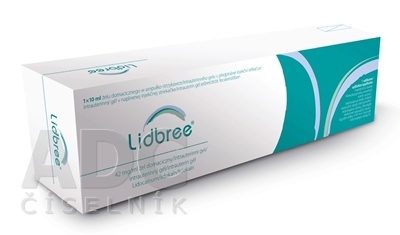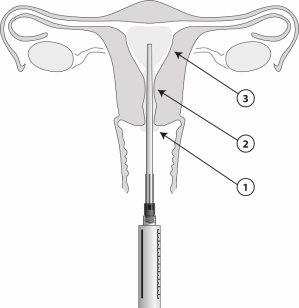

ЛИДБРИ 42 мг/мл ВНУТРИМАТЕРОЧНЫЙ ГЕЛЬ

Спросите врача о рецепте на ЛИДБРИ 42 мг/мл ВНУТРИМАТЕРОЧНЫЙ ГЕЛЬ

Инструкция по применению ЛИДБРИ 42 мг/мл ВНУТРИМАТЕРОЧНЫЙ ГЕЛЬ
Введение
ПРОСПЕКТ
Проспект:информация для пациента
Лидбри 42 мг/мл гель интравагинальный
лидокаин
Прочитайте внимательно весь проспект перед началом использования этого лекарства,поскольку он содержит важную информацию для вас.
- Сохраните этот проспект, поскольку вам может потребоваться прочитать его снова.
- Если у вас есть какие-либо сомнения, проконсультируйтесь с вашим врачом или фармацевтом.
- Это лекарство было назначено только вам, и не следует давать его другим людям, даже если у них такие же симптомы, как у вас, поскольку оно может нанести им вред.
- Если вы испытываете побочные эффекты, проконсультируйтесь с вашим врачом или фармацевтом, даже если это побочные эффекты, которые не указаны в этом проспекте. См. раздел 4.
Содержание проспекта
- Что такое Лидбри и для чего он используется
- Что нужно знать перед началом использования Лидбри
- Как использовать Лидбри
- Возможные побочные эффекты
5 Хранение Лидбри
- Содержание упаковки и дополнительная информация
1. Что такое Лидбри и для чего он используется
Лидбри - это анестезирующий гель, используемый для предотвращения боли при гинекологических процедурах, таких как введение противозачаточных устройств в матку и взятие биопсий для лабораторной оценки при гинекологических осмотрах, у взрослых и подростков старше 15 лет. Он содержит активное вещество лидокаин, местный анестетик амидного типа (который онемляет части тела, на которые он наносится).
Как действует Лидбри?
После нанесения геля требуется от 2 до 5 минут, прежде чем генитальная область (мукоза) онемеет. Было доказано, что гель уменьшает боль во время гинекологических процедур и до 30 минут после процедуры. Через 1 час анальгетический эффект исчезает.
2. Что нужно знать перед началом использования Лидбри
Не используйте Лидбри
Если вы аллергичны к лидокаину или к любому другому компоненту этого лекарства (включая раздел 6).
Предостережения и меры предосторожности
Используется исключительно путем введения в шейку матки и матку. После использования геля для введения внутриматочного противозачаточного устройства (ВМКУ), в случаях трудного введения, может произойти кровотечение и/или боль. В таких случаях необходимо немедленно провести физический осмотр и ультразвуковое исследование, чтобы исключить перфорацию матки или шейки матки. Средний показатель - 1 перфорация на 1000 процедур введения ВМКУ.
Сообщите медицинскому специалисту, который будет вводить Лидбри:
- если у вас есть нарушение сердечного ритма (частичный или полный блок сердечной проводимости), поскольку местные анестетики могут повлиять на него;
- если вы получаете лечение для нарушения сердечного ритма (с помощью блокаторов калиевых каналов или антиаритмических препаратов класса III, например, амиодарона), поскольку кардиальные эффекты могут увеличиться;
- если у вас есть состояние, называемое острой порфирией (наследственное состояние, связанное с одной из белковых фракций в крови). Лидокаин может вызвать приступы порфирии и должен быть назначен только в случаях крайней необходимости или при острой необходимости;
- если у вас плохое общее состояние здоровья.
Дети и подростки
Это лекарство не должно быть назначено детям младше 15 лет из-за риска побочных эффектов, вызванных высокими концентрациями лидокаина в крови.
Другие лекарства и Лидбри
Сообщите вашему врачу или фармацевту, если вы используете, недавно использовали или можете использовать любое другое лекарство, содержащее лидокаин, или лекарства для лечения нерегулярного сердечного ритма (антиаритмические препараты, такие как мексилетин или антиаритмические препараты класса III, такие как амиодарон), поскольку их эффекты на сердце будут добавляться к эффектам лидокаина.
Беременность, лактация и фертильность
На основе длительного опыта не известно, что лидокаин вызывает неблагоприятные эффекты на новорожденного.
Лидокаин может выделяться в грудное молоко, но в таких небольших количествах, что обычно нет риска для новорожденного. Следовательно, грудное вскармливание может продолжаться при лечении Лидбри.
Неизвестно, как лидокаин влияет на фертильность.
Вождение и использование машин
Лидбри имеет незначительное или отсутствующее влияние на способность управлять транспортными средствами и использовать машины.
Лидбри содержит рицинолеат макроголглицерола (полioxиловый масло рицина) и бутилированный гидроxytoluen
Рицинолеат макроголглицерола может вызывать тяжелые аллергические реакции.
Это лекарство может вызывать местные реакции на коже (такие как контактный дерматит) или раздражение глаз и слизистых оболочек, поскольку оно содержит бутилированный гидроxytoluen (Е321).
3. Как использовать Лидбри
Ваш врач или медсестра нанесут анестезирующий гель шаг за шагом, начиная с входа в матку.
Использование уподростков
Подростки с низким весом, весом тела ниже 30 кг, должны получать уменьшенную дозу.
Если вы используете больше Лидбри, чем необходимо
С рекомендуемыми дозами не ожидается, что произойдут следующие эффекты, однако, сообщите вашему врачу или медсестре немедленно, если вы испытываете онемение губ или языка, головокружение, звон в ушах (тиннитус) или имеете трудности с речью или зрением (зрительные расстройства), поскольку они могут быть первыми симптомами высоких концентраций лидокаина в крови. В некоторых случаях могут произойти мышечные спазмы или подергивания (тремор) или нарушения дыхания (апноэ), в этом случае ваш врач или медсестра должны быстро обеспечить правильное дыхание (поддержку дыхательных путей) и ввести противосудорожные препараты.
В случае передозировки или случайного приема проконсультируйтесь немедленно с вашим врачом или фармацевтом или позвоните в Токсикологическую информационную службу, телефон 91 562 04 20, указав лекарство и количество, использованное или проглоченное.
4. Возможные побочные эффекты
Как и все лекарства, это лекарство может вызывать побочные эффекты, хотя не все люди испытывают их.
Побочные эффекты, испытанные после использования Лидбри при введении внутриматочных противозачаточных устройств (матки), аналогичны тем, которые происходят при этом же процессе без применения Лидбри.
Возможные побочные эффекты:
- Очень частые(более 1 из 10 человек): тошнота (чувство дискомфорта).
- Частые(могут повлиять до 1 из 10 человек): головокружение, головная боль, неприятные ощущения в животе.
Сообщение о побочных эффектах
Если вы испытываете любой побочный эффект, проконсультируйтесь с вашим врачом, фармацевтом или медсестрой, даже если это возможные побочные эффекты, которые не указаны в этом проспекте. Вы также можете сообщить о них напрямую через Испанскую систему фармаковигиланса для лекарств для человека: https://www.notificaram.es Сообщая о побочных эффектах, вы можете способствовать предоставлению более полной информации о безопасности этого лекарства.
5. Хранение Лидбри
Храните это лекарство в недоступном для детей месте.
Не используйте это лекарство после даты истечения срока годности (месяц-год) на упаковке и на шприце. Дата истечения срока годности - последний день указанного месяца.
Это лекарство не требует специальных условий хранения.
Лекарства не должны выбрасываться в канализацию или мусор. Поместите упаковку и лекарства, которые вам больше не нужны, в пункт SIGRE аптеки. В случае сомнений проконсультируйтесь с вашим фармацевтом, как правильно утилизировать упаковку и лекарства, которые вам больше не нужны. Таким образом, вы поможете защитить окружающую среду.
6. Содержание упаковки и дополнительная информация
Состав Лидбри
- Активное вещество - лидокаин. Каждый мл геля внутриматочного содержит 42 мг лидокаина.
- Другие компоненты:
- Рицинолеат макроголглицерола (полioxиловое масло рицина)
- Полoxамер (содержит бутилированный гидроxytoluen (Е 321))
- Аскорбат натрия (Е 301)
- Хлористоводородная кислота для регулирования pH
- Гидроксид натрия для регулирования pH
- Вода для инъекций
Внешний вид продукта и содержание упаковки
Продукт представляет собой внутриматочный гель (в матке), который является стерильным, прозрачным или почти прозрачным, вязкой жидкостью с легким коричневато-желтым оттенком при комнатной температуре, содержащей 42 мг/мл лидокаина. Формула показывает обратимую термогелляцию, зависящую от температуры, это гель при температуре тела (термогелляция). Внутриматочный гель Лидбри 42 мг/мл выпускается в стерильном предварительно заполненном шприце объемом 10 мл (циклический олефиновый сополимер) с пробкой из бромобутиловой резины и крышкой, упакованным в блистер с поршневой штангой. Шприц градуируется в мл. В отдельном пакете внутри коробки поставляется стерильный аппликатор (полипропилен) с блокирующим устройством Luer, совместимым с предварительно заполненным шприцем. Из аппликатора можно извлечь 8,5 мл геля.
Размер упаковки: 1 × 10 мл внутриматочного геля в предварительно заполненном шприце.
Символы на этикетке аппликатора Лидбри
|
|
|
|
|
Номер каталога | Код партии | Не использовать, если упаковка повреждена | Не повторно использовать | Маркировка CE |
|
|
|
| |
Производитель | Срок годности | Стерильно путем облучения | Прочитайте инструкцию по применению |
Владелец разрешения на маркетинг и ответственный за производство
Владелец разрешения на маркетинг
Gedeon Richter Plc.
Gyömroi út 19-21.
Будапешт H-1103
Венгрия
Производители:
Recipharm Karlskoga AB
Björkbornsvägen 5
SE691 33 Karlskoga
Швеция
Gedeon Richter Plc.
Gyömroi út 19-21.
Будапешт H-1103 Венгрия
Вы можете получить дополнительную информацию о этом лекарстве, обратившись к местному представителю владельца разрешения на маркетинг:
Gedeon Richter Ibérica, S.A.
Sabino Arana, 28 - 4º 2ª
08028 Барселона
Испания
Это лекарство разрешено в странах-членах Европейского экономического пространства под следующими названиями:
Австрия, Бельгия, Болгария, Кипр, Чехия, Германия, Дания, Эстония, Греция, Испания, Финляндия, Франция, Хорватия, Венгрия, Ирландия, Исландия, Италия, Люксембург, Латвия, Литва, Мальта, Норвегия, Польша, Португалия, Великобритания, Румыния, Швеция, Словения, Словакия: Лидбри
Дата последнего пересмотра этогопроспекта:Июнь2020
Подробная и актуальная информация о этом лекарстве доступна на сайте Испанского агентства по лекарствам и медицинским изделиям (AEMPS) (http://www.aemps.gob.es/)}>
----------------------------------------------------------------------------------------------------------------------------------
Эта информация предназначена только для медицинских специалистов:
Используется исключительно путем введения в шейку матки и матку.
После использования Лидбри, в случаях трудного введения и/или сильной боли или кровотечения во время или после введения, необходимо немедленно провести физический осмотр и ультразвуковое исследование, чтобы исключить перфорацию матки или шейки матки, поскольку, как и при эффективной местной анестезии, пациент может не реагировать на боль в случае перфорации.
Термогелляционная формула:Лидбри - это местный анестетик, вязкая жидкость, термогелляционная, без консервантов. Формула образует гель при повышении температуры до температуры тела, оставаясь прикрепленной к слизистой оболочке шейки матки и матки (минимизируя потери, которые могли бы произойти с жидкой формулой).
Метод применения и доза
Лидбри должен быть введен в жидком состоянии. Если образовался гель, поместите шприц в холодильник до тех пор, пока он не станет жидким снова. Воздушный пузырь, видимый в шприце, движется, когда шприц наклонен.
Подготовьте стерильный аппликатор, включенный в упаковку, следуя указанным шагам, и нанесите лекарство:
- Проверьте вид шприца, когда он наклонен. Воздушный пузырь будет двигаться при наклоне шприца, когда продукт находится в жидком состоянии и готов к использованию. Если воздушный пузырь не движется, это означает, что образовался гель, в этом случае шприц необходимо поместить в холодильник до тех пор, пока он не станет жидким снова.
- Подключите поршневую штангу и аппликатор к шприцу, убедившись, что они хорошо соединены.

- Удалите воздушный пузырь и наполните аппликатор гелем, осторожно нажимая на поршневую штангу шприца.
- Используйте шкалу в сантиметрах на аппликаторе, чтобы измерить количество Лидбри.
После установки аппликатора можно ввести 8,5 мл геля из шприца. 1 мл содержит 42 мг лидокаина. Нанесите гель шаг за шагом (1-3), как показано на схеме.

Шейные процедуры
- Используя стерильный аппликатор, нанесите 2-3 мл геля толстым слоем на экзоцервикс.
- Используя аппликатор, введите 3 мл в шейку матки за 5 минут до начала процедуры.
Внутриматочные процедуры
- Используя стерильный аппликатор, нанесите 1-2 мл геля на переднюю губу экзоцервикса.
- Используя аппликатор, введите 2-3 мл в шейку матки. Подождите 2 минуты, чтобы начался эффект в внутреннем канале.
- Затем введите аппликатор в полость матки и введите 3-5 мл геля за 5 минут до процедуры. Аппликатор имеет шкалу в сантиметрах. Можно ввести меньший объем, например, у пациенток с низким весом, если пациентка испытывает дискомфорт до окончания введения всего объема.
Одна внутриматочная доза не должна превышать 10 мл. Утилизируйте неиспользованный содержимое.
Педиатрическое население от 15 лет.
У подростков с низким весом, весом тела ниже 30 кг, дозу необходимо уменьшить пропорционально, максимальная единовременная доза не должна превышать максимально рекомендуемую парентеральную дозу (6 мг/кг хлорид лидокаина, что соответствует 5,2 мг/кг основы лидокаина в Лидбри, т.е. 1,2 мл на 10 кг веса тела). У подростков с весом тела 30 кг максимальная доза Лидбри составляет 3,6 мл в общей сложности.
Продолжительность действия
Было доказано, что гель уменьшает боль во время гинекологических процедур и до 30 минут после процедуры. Через 1 час анальгетический эффект исчезает.
- Страна регистрации
- Активное вещество
- Требуется рецептДа
- Производитель
- Информация носит справочный характер и не является медицинской рекомендацией. Перед приемом любых препаратов проконсультируйтесь с врачом. Oladoctor не несет ответственности за медицинские решения, принятые на основе этого контента.
- Аналоги ЛИДБРИ 42 мг/мл ВНУТРИМАТЕРОЧНЫЙ ГЕЛЬФорма выпуска: ПЕРЕВЯЗОЧНЫЙ МАТЕРИАЛ, 700 мгАктивное вещество: ЛидокаинПроизводитель: Grünenthal Pharma S.A.Требуется рецептФорма выпуска: ГЕЛЬ/ПАСТА/ЖИДКИЙ ДЛЯ ПРИЕМА ВНУТРЬ, 20 мг/гАктивное вещество: ЛидокаинПроизводитель: Chemische Fabrik Kreussler & Co GmbhНе требуется рецептФорма выпуска: ГЕЛЬ, 20 мг/млАктивное вещество: ЛидокаинПроизводитель: Farco-Pharma GmbhТребуется рецепт
Аналоги ЛИДБРИ 42 мг/мл ВНУТРИМАТЕРОЧНЫЙ ГЕЛЬ в других странах
Лучшие аналоги с тем же действующим веществом и терапевтическим эффектом.
Аналог ЛИДБРИ 42 мг/мл ВНУТРИМАТЕРОЧНЫЙ ГЕЛЬ в Польша
Аналог ЛИДБРИ 42 мг/мл ВНУТРИМАТЕРОЧНЫЙ ГЕЛЬ в Украина
Врачи онлайн по ЛИДБРИ 42 мг/мл ВНУТРИМАТЕРОЧНЫЙ ГЕЛЬ
Консультация по дозировке, побочным эффектам, взаимодействиям, противопоказаниям и продлению рецепта на ЛИДБРИ 42 мг/мл ВНУТРИМАТЕРОЧНЫЙ ГЕЛЬ – по решению врача и с учетом местных правил.























